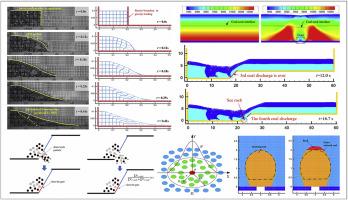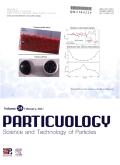Improved mesh-free SPH approach for loose top coal caving modeling
IF 4.1
2区 材料科学
Q2 ENGINEERING, CHEMICAL
引用次数: 0
Abstract
This study presents an innovative model in computational geotechnical engineering by improving the Smoothed Particle Hydrodynamics (SPH) method for simulating loose particle dynamics in coal caving processes. The improved model integrates an elastic-perfectly plastic constitutive model with the Drucker-Prager yield criterion and includes several improvements aimed at boosting accuracy, stability, and efficiency. These improvements include gravity loading coupled with particle damping, first-order stress field smoothing, and kernel gradient correction. A series of numerical experiments validates the effectiveness of the improved SPH model, demonstrating its capability to predict large deformations and track the evolution of the coal-rock interface in coal caving processes. Furthermore, the study analyzes the model's sensitivity to material parameters such as the angle of friction and material density, which aids in configuring the model for distinct coal mining situations. Results show that the non-cohesive elastic-perfectly plastic constitutive model can effectively simulate the flow behavior of granular particles, and the landslide simulation results are in good agreement with the experiments. The improved SPH algorithm with stress smoothing technique solves the problem of numerical noise, and the “double peak” stress distribution around the coal outlet is identified. The established SPH model offers an effective tool for understanding dynamics behaviors of loose top coal. Significantly, the model requires only five material parameters, which can be identified through standard experiments, avoiding the typically arduous process of parameter selection or calibration commonly existing in Discrete Element Method simulations.

松散顶煤塌陷模型的改进型无网格 SPH 方法
本研究通过改进平滑粒子流体动力学(SPH)方法,提出了一种计算岩土工程中的创新模型,用于模拟煤炭采空区过程中的松散粒子动力学。改进后的模型将弹性-完全塑性构造模型与德鲁克-普拉格屈服准则整合在一起,并进行了多项改进,旨在提高精度、稳定性和效率。这些改进包括重力加载耦合颗粒阻尼、一阶应力场平滑和核梯度校正。一系列数值实验验证了改进后的 SPH 模型的有效性,证明其有能力预测大变形,并跟踪煤炭塌陷过程中煤岩界面的演变。此外,研究还分析了模型对摩擦角和材料密度等材料参数的敏感性,这有助于针对不同的采煤情况配置模型。结果表明,非粘性弹性-完全塑性组成模型能有效模拟颗粒的流动行为,滑坡模拟结果与实验结果吻合良好。采用应力平滑技术的改进型 SPH 算法解决了数值噪声问题,并确定了煤炭出口周围的 "双峰 "应力分布。所建立的 SPH 模型为了解松散顶煤的动力学行为提供了有效工具。值得注意的是,该模型只需要五个材料参数,这些参数可以通过标准实验确定,避免了离散元法模拟中常见的参数选择或校准过程。
本文章由计算机程序翻译,如有差异,请以英文原文为准。
求助全文
约1分钟内获得全文
求助全文
来源期刊

Particuology
工程技术-材料科学:综合
CiteScore
6.70
自引率
2.90%
发文量
1730
审稿时长
32 days
期刊介绍:
The word ‘particuology’ was coined to parallel the discipline for the science and technology of particles.
Particuology is an interdisciplinary journal that publishes frontier research articles and critical reviews on the discovery, formulation and engineering of particulate materials, processes and systems. It especially welcomes contributions utilising advanced theoretical, modelling and measurement methods to enable the discovery and creation of new particulate materials, and the manufacturing of functional particulate-based products, such as sensors.
Papers are handled by Thematic Editors who oversee contributions from specific subject fields. These fields are classified into: Particle Synthesis and Modification; Particle Characterization and Measurement; Granular Systems and Bulk Solids Technology; Fluidization and Particle-Fluid Systems; Aerosols; and Applications of Particle Technology.
Key topics concerning the creation and processing of particulates include:
-Modelling and simulation of particle formation, collective behaviour of particles and systems for particle production over a broad spectrum of length scales
-Mining of experimental data for particle synthesis and surface properties to facilitate the creation of new materials and processes
-Particle design and preparation including controlled response and sensing functionalities in formation, delivery systems and biological systems, etc.
-Experimental and computational methods for visualization and analysis of particulate system.
These topics are broadly relevant to the production of materials, pharmaceuticals and food, and to the conversion of energy resources to fuels and protection of the environment.
 求助内容:
求助内容: 应助结果提醒方式:
应助结果提醒方式:


